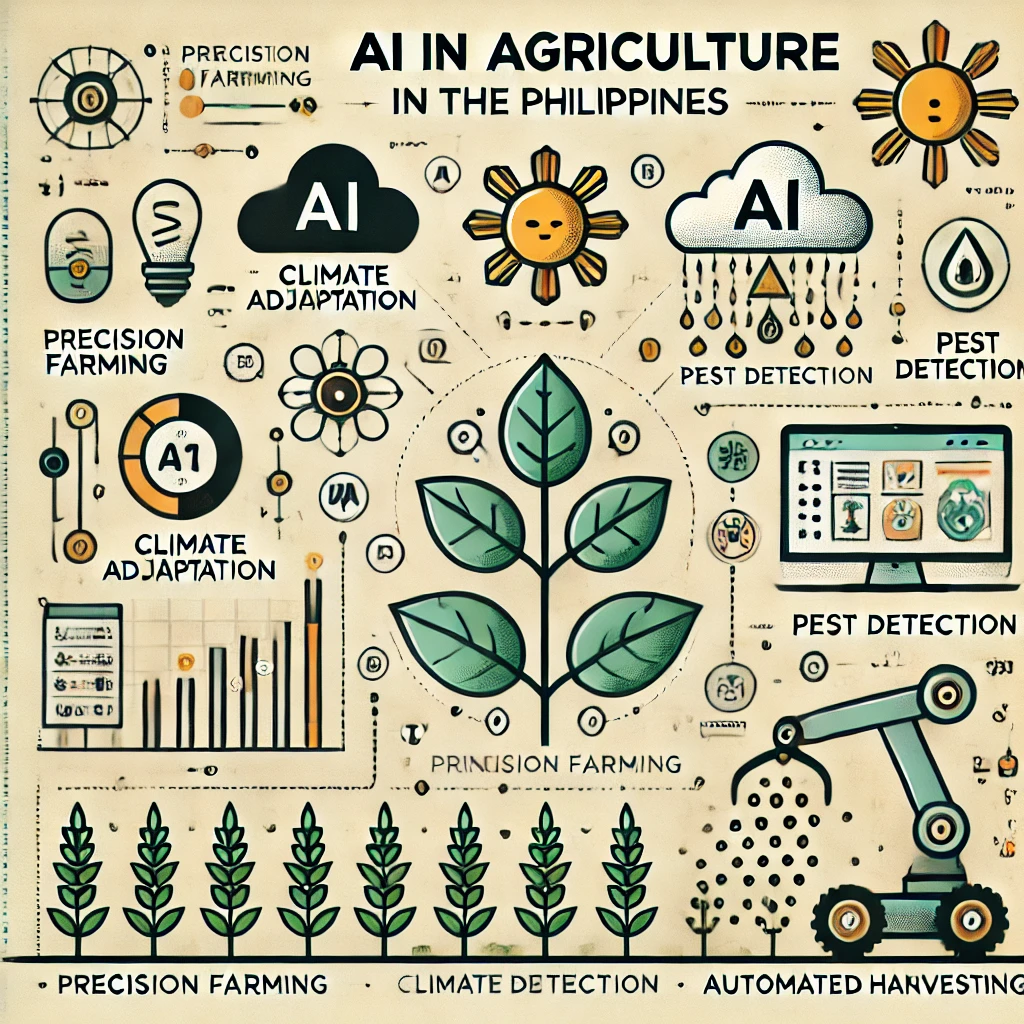The agricultural sector in the Philippines is a critical backbone of the economy, supporting millions of livelihoods and ensuring food security for the nation. However, it faces challenges like climate change, inefficient farming methods, and limited access to modern technology. With the integration of Artificial Intelligence (AI), the future of agriculture in the Philippines can be transformed into a more efficient, sustainable, and resilient system.
The Role of AI in Philippine Agriculture
AI technologies, such as machine learning, image recognition, and robotics, can address several pressing issues in agriculture. Here are some of the most impactful applications:
- Precision Farming: AI-driven precision agriculture uses data from soil sensors, weather stations, and satellite imagery to optimize planting, irrigation, and harvesting. By predicting the best times for planting and applying water and fertilizers more efficiently, farmers can increase crop yields while minimizing resource use.
- Climate Adaptation: The Philippines is particularly vulnerable to typhoons, droughts, and floods. AI can be used to create predictive models based on historical weather data, helping farmers plan and adapt to changing climate patterns. AI algorithms can also offer recommendations on the most climate-resilient crops for different regions.
- Pest and Disease Detection: AI-powered image recognition tools can detect plant diseases or pests before they spread, reducing crop damage. Farmers can use smartphone apps that leverage AI to diagnose issues simply by taking a picture of an infected plant.
- Automated Harvesting and Labor Optimization: Robotics and AI-based harvesting equipment are transforming labor-intensive tasks into automated processes, helping to reduce labor shortages and increase productivity. This can especially benefit large-scale farms in the Philippines, where access to farm labor can be inconsistent.
- Supply Chain Optimization: AI can enhance the entire agricultural supply chain, from farm to market. Machine learning algorithms can predict demand and help farmers reduce food waste by aligning production levels with market needs, optimizing storage, and transportation logistics.
Case Studies of AI in Agriculture
Countries like the United States, India, and Japan are already leveraging AI to modernize their agricultural sectors. For instance, Japan has developed AI-powered robots for harvesting crops like tomatoes and cucumbers, helping to counteract labor shortages in farming. Similarly, India’s AI tools predict weather patterns to assist farmers in making informed decisions about planting and irrigation schedules.
The Philippines can benefit from adopting similar AI-driven innovations. By integrating AI, not only would the country enhance its food security, but it could also improve agricultural export competitiveness.
Challenges to Adoption in the Philippines
While the potential of AI in agriculture is significant, several challenges stand in the way of widespread adoption:
- Limited Access to Technology: Many smallholder farmers lack access to modern technologies, and rural infrastructure remains underdeveloped. Internet connectivity, a prerequisite for many AI tools, is also limited in remote agricultural areas.
- Cost: The initial investment for AI-driven tools like robotics or advanced sensors may be too high for small-scale farmers.
- Training and Education: Farmers need to be educated on how to use AI technologies effectively. Government-led initiatives or partnerships with private tech companies could bridge this knowledge gap.
Government Role in Promoting AI in Agriculture
For AI in agriculture to thrive, the Philippine government must actively support its adoption through policies, subsidies, and educational programs. The government can:
- Provide Incentives: Offering financial support for smallholder farmers to invest in AI tools could accelerate adoption.
- Promote Public-Private Partnerships: Collaborations between AI tech companies and government agencies could create affordable solutions tailored to the needs of Filipino farmers.
- Invest in Infrastructure: Expanding internet connectivity and building infrastructure to support digital farming is essential for a successful AI integration.
Conclusion
AI presents a game-changing opportunity to revolutionize agriculture in the Philippines. By embracing AI, the country can increase crop yields, combat climate challenges, and enhance food security, all while making farming more efficient and sustainable. It is crucial for the Philippine government to take proactive steps in supporting this transition, ensuring the agricultural sector’s long-term viability and growth.
“I, Evert-Jan Wagenaar, resident of the Philippines, have a warm heart for the country. The same applies to Artificial Intelligence (AI). I have extensive knowledge and the necessary skills to make the combination a great success. I offer myself as an external advisor to the government of the Philippines. Please contact me using the Contact form or email me directly at evert.wagenaar@gmail.com!”
Let me know if you’d like to make any adjustments!
[SEO optimized]

